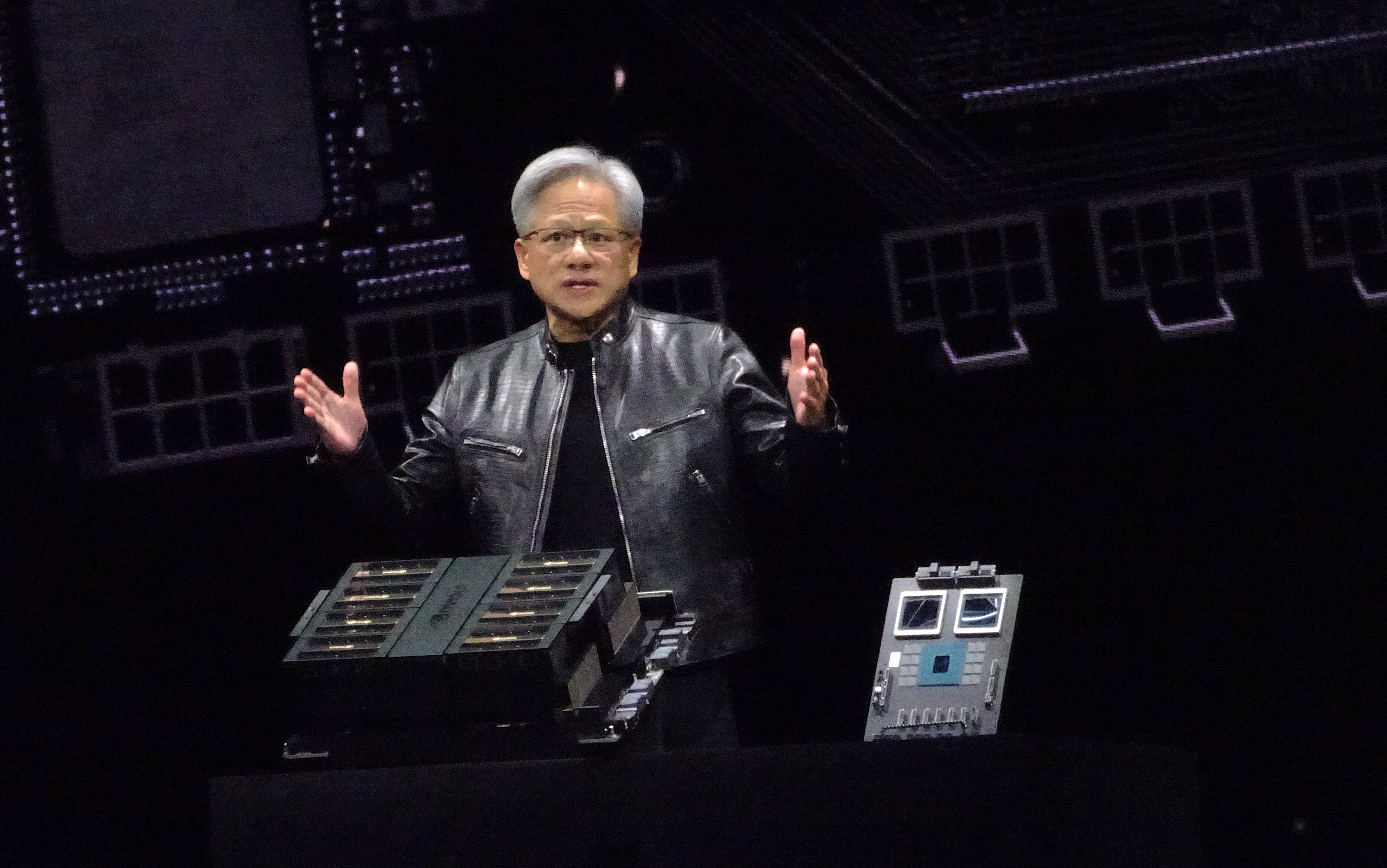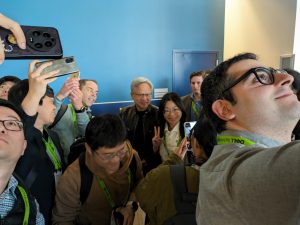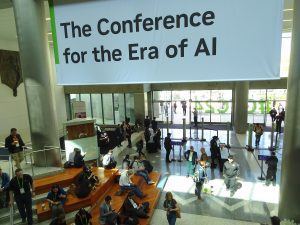 AI
AI
 AI
AI
 AI
AI
AI continued to dominate the news this week, no more so than at Nvidia’s annual GTC conference in San Jose, which arguably kicked off the real start of the next era of artificial intelligence.
“The conference for the Era of AI,” as the company called it, was jam-packed — so much so that CEO Jensen Huang (pictured) had to move his signature keynote to the nearby sports and concert venue SAP Center. The expo hall was gridlocked even by the third day, and one session, Huang’s fireside chat with seven of the eight authors of a seminal 2017 paper that launched generative AI into the tech mainstream, had to be capped at 1,800 people. Not least, Huang himself emerged as a major tech star, followed around for selfies by attendees and even, embarrassingly, some journalists.
Much more on that below, but that wasn’t even the only AI news, as new models from Apple, Elon Musk’s x.AI and more were released and new funding rounds continued for startups — even as earlier startups such as Inflection AI and Stability AI look to be struggling.
Meantime, it’s possible the initial public offering window is opening. Intel-backed Astera Labs and the social media site Reddit both saw their stock pop in their IPOs.
Not least, the Department of Justice’s hammer came down on Apple as it sued the iPhone maker on antitrust grounds.
This and other news, including the upshot of GTC, the rise of Broadcom as an AI powerhouse, and who’s going to create the leading AI factories, were discussed and analyzed in John Furrier’s and Dave Vellante’s weekly podcast theCUBE Pod, available now on YouTube. And catch Vellante’s weekly deep tech dive, Breaking Analysis, coming Saturday.
Here are the news highlights from this week:


OK, on to our coverage:
Check out editorial interviews from Furrier, Vellante and others on theCUBE onsite this past week.
Blackwell: Nvidia’s GPU architecture to power new generation of 1T-parameter generative AI models
Keynote analysis from Nvidia GTC 2024: Spearheading AI and accelerated computing innovation
Nvidia GTC 2024 day two analysis: Generative AI emerges as the new seed of innovation
Nvidia releases Blackwell platform to go back to the future, extends partnership with AWS for scale
Nvidia’s new microservices APIs promise to speed up AI development
Nvidia unveils Project GR00T AI foundation model for humanoid robots
Nvidia announces APIs for Omniverse Cloud to power digital twins for software tools
Nvidia’s newest cloud service promises to accelerate quantum computing simulations
Nvidia’s latest generative AI model LATTE3D can create 3D images and shapes in seconds
Dell expands infrastructure portfolio with new Nvidia-powered AI platforms
HPE debuts its Nvidia GPU-powered on-premises supercomputer for generative AI
ServiceNow injects more generative AI capabilities into its workflow platform
CrowdStrike and Nvidia form strategic partnership to enhance cybersecurity with AI
Kinetica ramps up RAG for generative AI, empowering enterprises with real-time operational data
Dataloop and Nvidia collaborate to enhance AI application development for businesses
Meteomatics collaborates with Nvidia to enhance its hyper-local weather forecasts with AI
Report: Nvidia could pay up to $1B to acquire AI infrastructure startup Run:ai
Report: GPU cloud operator CoreWeave seeking new funding at $16B valuation
Databricks acquires text dataset management startup Lilac
Report: Apple in talks with Google to use Google Gemini AI model on iPhone
Google fined $272M by French government over AI use of news content
United Nations gives green light to first resolution on artificial intelligence
Elon Musk’s xAI releases Grok-1 architecture, while Apple advances multimodal AI research
Japanese startup Sakana releases AI models created through ‘evolutionary’ processes
Stability AI launches new model that turns images into 3D videos
Foundry launches with $80M in funding to build an AI-optimized public cloud
Healthcare industry chatbot firm Hippocratic AI raises $53M at $500M valuation
Startup Borderless AI nets $27M to bring generative AI to global hiring practices
Balbix’s BX4 engine leverages Nvidia AI to transform cybersecurity risk management
Google DeepMind develops an AI with Liverpool Football Club to predict plays in the game
Snowflake documents huge growth in AI projects
ClearML debuts open-source Fractional GPU tool and new monitoring features
DHS introduces AI pilots to enhance public safety and immigration processes
Catch theCUBE’s coverage of KubeCon+CloudNativeCon here, and there’s more to come. For the TL;DR, here’s a closing overview: Cloud-native community celebrates Kubernetes’ ‘Linux moment’ and its growing role in enterprise AI And a dive by Intellyx’s Jason Bloomberg into significant startups leading the way: Platform engineering, API platforms and intelligent agents dominate innovation at KubeCon Paris
IPO winter ending? Astera Labs and Reddit surge in stock trading debuts Databricks, Arctic Wolf and a few others will be watching closely.
Intel wins $19.5B in CHIPS Act funding and loans for fab network expansion
Cisco completes its $28B acquisition of Splunk
Micron’s stock posts huge gain after crushing forecasts in its latest earnings results
Qualcomm’s new Snapdragon 7+ Gen 3 chip brings generative AI to midrange smartphones
Microsoft debuts enterprise-focused Surface Pro 10 and Surface Laptop 6
Redis acquires storage engine startup Speedb to enhance its open-source database
Google releases second developer preview for Android 15
Confluent simplifies integration between Kafka stream processing and Iceberg storage
Sonatype debuts SBOM Manager to make enterprise software more transparent
IBM acquires Pliant to boost network IT automation capabilities
Jama Software to be acquired by Francisco Partners for $1.2B in significant exit for Portland-based company (from Geekwire)
Exclusive: Dymium launches with platform that takes protection to the data
Data security startup BigID valued at $1B+ following $60M round
Cyber risk startup CyberSaint raises $21M for platform development and expansion
Newcomer BlueFlag Security raises $11.5M for developer-centric security platform
Researchers uncover unfixable vulnerability in Apple CPUs affecting cryptographic security
Deloitte introduces CyberSphere to enhance cyber operational efficiency with automation and AI
Darwinium introduces behavior identification to strengthen online transaction security
DOJ sues Apple over antitrust violations related to iPhones
Neuralink’s first brain implant patient says playing chess with his mind is like ‘using the force’
Supreme Court tackles controversial topic of Biden administration-big tech cooperation
Microsoft will reportedly debut new Qualcomm-powered Surface devices in May
Figure Markets raises $60M to build crypto ‘everything marketplace’
Morph raises $20M to build consumer-focused Ethereum scaling blockchain solution
Microsoft appoints Inflection AI CEO Mustafa Suleyman to lead its consumer AI unit Despite speculation that this was a way for Microsoft to avoid antitrust scrutiny, I’m thinking this will do just the opposite.
And that’s not the only departure from a high-profile AI company: Three of Stable Diffusion’s original developers reportedly leave Stability AI
Paul Cormier, chairman and former CEO of Red Hat, is retiring.
Skyhigh Security appoints former Snow Software CEO Vishal Rao as new CEO Meantime, Amazon Web Services hired former Skyhigh CEO Gee Rittenhouse to be VP of enterprise security.
Google shuffles search leadership: Liz Reid, who was heading up core search experiences, is now head of Search. Cheenu Venkatachary is new lead of Search quality and ranking, replacing Pandu Nayak, who becomes chief scientist of Search. Cathy Edwards is moving to the Long-term Bets team in Knowledge and Information (from Search Engine Land).
Former Goldman Sachs executive Stephanie Cohen joined Cloudflare as chief strategy officer.
Support our mission to keep content open and free by engaging with theCUBE community. Join theCUBE’s Alumni Trust Network, where technology leaders connect, share intelligence and create opportunities.
Founded by tech visionaries John Furrier and Dave Vellante, SiliconANGLE Media has built a dynamic ecosystem of industry-leading digital media brands that reach 15+ million elite tech professionals. Our new proprietary theCUBE AI Video Cloud is breaking ground in audience interaction, leveraging theCUBEai.com neural network to help technology companies make data-driven decisions and stay at the forefront of industry conversations.